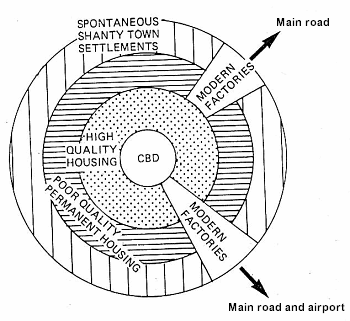Urban Land Use Patterns: LEDCs
The land use model which has evolved is true mainly for Brazilian cities, although it can be applied to other cities in the world, including Zomba in Malawi. The main characteristics of the model of Sao Paulo (below) are:
1. The Central Business District; contains the main businesses, shopping centres and entertainment of the urban area.
2. High status housing surrounds the CBD. This includes high-rise expensive modern apartment blocks, many with their own security guards. This pattern is the opposite to that of cities in MEDCs. Inner city districts of MEDCs date back to the factories and tenement blocks of the Industrial Revolution, whereas the area surrounding the CBD in LEDCs dates from colonial times when it housed the colony's administrators and Governor. It consequently has the infrastructure - electricity, telephones, sewerage, water, etc. not found in other parts of the urban area.
3. Surrounding the high-quality residential area is poor to medium quality housing which started out as a shanty town. It has now been provided with some basic amenities (the periferia).
4. Shanty towns (spontaneous squatter settlements or favellas) are found on the steep hillsides, swamps or waste land surrounding the city.
5. Modern factories are found along main roads, sometimes with favellas in between.
There are also areas on the periphery of low-cost housing funded by the government which have basic amenities. In addition there is suburban high status, low density housing for executive and professional classes.
 |
Model of Saõ Paulo (simplified urban structure)
See: Zomba Urban Model | LEDC Urban Land Use for an LEDC urban model case study
